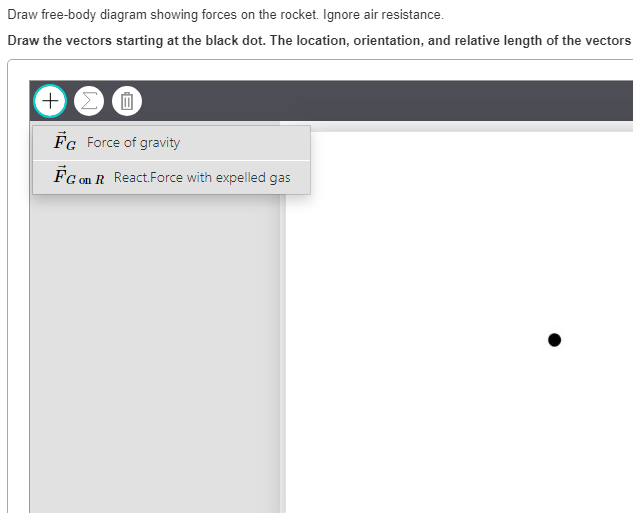Draw free-body diagram showing forces on the rocket. Ignore air resistance. Draw the vectors starting at the black dot. The location, orientation, and relative length of the vectors
Draw free-body diagram showing forces on the rocket. Ignore air resistance. Draw the vectors starting at the black dot. The location, orientation, and relative length of the vectors
College Physics
1st Edition
ISBN:9781938168000
Author:Paul Peter Urone, Roger Hinrichs
Publisher:Paul Peter Urone, Roger Hinrichs
Chapter4: Dynamics: Force And Newton's Laws Of Motion
Section: Chapter Questions
Problem 16PE: A brave but inadequate rugby player is being pushed backward by an opposing player who is exerting a...
Related questions
Question

Transcribed Image Text:Draw free-body diagram showing forces on the rocket. Ignore air resistance.
Draw the vectors starting at the black dot. The location, orientation, and relative length of the vectors
ΣΠ
Fc Force of gravity
FG on R React.Force with expelled gas
+

Transcribed Image Text:Part A
How does a rocket take off? What is the upward force on it?
O The rocket forces the exhaust gases down, and the hot gases push up on the rocket. The two forces are a Newton's second-law pair. The rocket accelerates upward because the force of the exhaust gases on the rocket is greater than the force of gravity.
O The rocket forces the exhaust gases down, and the hot gases push up on the rocket. The two forces are a Newton's second-law pair. The rocket accelerates upward because the force of the exhaust gases on the rocket is greater than the rocket force on the exhaust gases.
O The rocket forces the exhaust gases down, and the hot gases push up on the rocket. The two forces are a Newton's third-law pair. The rocket accelerates upward because the force of the exhaust gases on the rocket is greater than the force of gravity.
O The rocket forces the exhaust gases down, and the hot gases push up on the rocket. The two forces are a Newton's third-law pair. The rocket accelerates upward because the force of the exhaust gases on the rocket is greater than the rocket force on the exhaust gases.
Submit
Request Answer
Expert Solution
This question has been solved!
Explore an expertly crafted, step-by-step solution for a thorough understanding of key concepts.
This is a popular solution!
Trending now
This is a popular solution!
Step by step
Solved in 4 steps with 2 images

Knowledge Booster
Learn more about
Need a deep-dive on the concept behind this application? Look no further. Learn more about this topic, physics and related others by exploring similar questions and additional content below.Recommended textbooks for you

College Physics
Physics
ISBN:
9781938168000
Author:
Paul Peter Urone, Roger Hinrichs
Publisher:
OpenStax College

University Physics Volume 1
Physics
ISBN:
9781938168277
Author:
William Moebs, Samuel J. Ling, Jeff Sanny
Publisher:
OpenStax - Rice University

Glencoe Physics: Principles and Problems, Student…
Physics
ISBN:
9780078807213
Author:
Paul W. Zitzewitz
Publisher:
Glencoe/McGraw-Hill

College Physics
Physics
ISBN:
9781938168000
Author:
Paul Peter Urone, Roger Hinrichs
Publisher:
OpenStax College

University Physics Volume 1
Physics
ISBN:
9781938168277
Author:
William Moebs, Samuel J. Ling, Jeff Sanny
Publisher:
OpenStax - Rice University

Glencoe Physics: Principles and Problems, Student…
Physics
ISBN:
9780078807213
Author:
Paul W. Zitzewitz
Publisher:
Glencoe/McGraw-Hill

Principles of Physics: A Calculus-Based Text
Physics
ISBN:
9781133104261
Author:
Raymond A. Serway, John W. Jewett
Publisher:
Cengage Learning

Physics for Scientists and Engineers: Foundations…
Physics
ISBN:
9781133939146
Author:
Katz, Debora M.
Publisher:
Cengage Learning